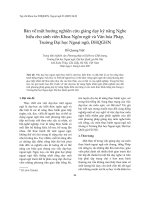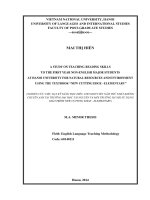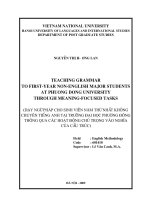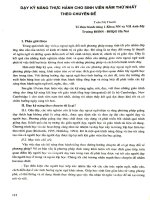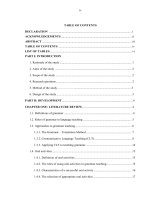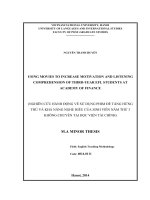nghiên cứu việc dạy kỹ năng đọc hiểu cho sinh viên năm thứ nhất không chuyên anh tại trường đại học tài nguyên và môi trường hà nội sử dụng giáo trình new cutting edge - elementary
Bạn đang xem bản rút gọn của tài liệu. Xem và tải ngay bản đầy đủ của tài liệu tại đây (1.37 MB, 76 trang )
VIETNAM NATIONAL UNIVERSITY, HANOI
UNIVERSITY OF LANGUAGES AND INTERNATIONAL STUDIES
FACULTY OF POST-GRADUATE STUDIES
MAI THỊ HIỀN
A STUDY ON TEACHING READING SKILLS
TO THE FIRST YEAR NON-ENGLISH MAJOR STUDENTS
AT HANOI UNIVERSITY FOR NATURAL RESOURCES AND ENVIRONMENT
USING THE TEXTBOOK “NEW CUTTING EDGE –ELEMENTARY”
(NGHIÊN CỨU VIỆC DẠY KỸ NĂNG ĐỌC HIỂU CHO SINH VIÊN NĂM THỨ NHẤT KHÔNG
CHUYÊN ANH TẠI TRƯỜNG ĐẠI HỌC TÀI NGUYÊN VÀ MÔI TRƯỜNG HÀ NỘI SỬ DỤNG
GIÁO TRÌNH NEW CUTTING EDGE - ELEMENTARY)
M.A. MINOR THESIS
Field: English Language Teaching Methodology
Code: 60140111
Hanoi, 2014
VIETNAM NATIONAL UNIVERSITY, HANOI
UNIVERSITY OF LANGUAGES AND INTERNATIONAL STUDIES
FACULTY OF POST-GRADUATE STUDIES
MAI THỊ HIỀN
A STUDY ON TEACHING READING SKILLS
TO THE FIRST YEAR NON-ENGLISH MAJOR STUDENTS
AT HANOI UNIVERSITY FOR NATURAL RESOURCES AND ENVIRONMENT
USING THE TEXTBOOK “NEW CUTTING EDGE –ELEMENTARY”
(NGHIÊN CỨU VIỆC DẠY KỸ NĂNG ĐỌC HIỂU CHO SINH VIÊN NĂM THỨ NHẤT KHÔNG
CHUYÊN ANH TẠI TRƯỜNG ĐẠI HỌC TÀI NGUYÊN VÀ MÔI TRƯỜNG HÀ NỘI SỬ DỤNG
GIÁO TRÌNH NEW CUTTING EDGE - ELEMENTARY)
M.A. MINOR THESIS
Field: English Language Teaching Methodology
Code: 60140111
Supervisor: Dr.Tran Thi Thu Hien
Hanoi, 2014
i
DECLARATIONS
I, Mai Thi Hien, hereby certify that this minor thesis entitled “A study on
teaching reading skills to the first year non-English major students at Hanoi
University for Natural Resources and Environment using the textbook “New
Cutting Edge –Elementary” is the result of my own research in the fulfillment of
the requirement for the Degree of Master of Arts at Faculty of Post Graduate
Studies - University of Languages and International Studies – Vietnam National
University, Hanoi.
Mai Thi Hien
ii
ACKNOWLEDGEMENTS
First and foremost, I would like to show my deep gratitude to all the lecturers
at University of Languages and International Studies – Vietnam National
University, Hanoi for the invaluable lectures, which laid the foundation for my
thesis.
I would like to register my deep gratitude to Ms. Tran Thi Thu Hien for her
ever-enthusiasm, responsibility and devotion. Thanks to her critical feedbacks,
invaluable suggestions and constant encouragement the study has been timely
completed.
My special thanks also go to my colleagues who are also teachers of Hanoi
University for Natural Resources and Environment. I wish to express my
thankfulness to all the first year students at the University for their cooperation and
support for my data collection, providing me with insights into reading skills
learning, reading texts and their teachers‟ performance.
Last but not least, I would like to delicate to my family and friends for their
constant assistance and encouragement during the time I carry out the research.
Without them I believe the study could not be completed.
iii
ABSTRACT
This study is an attempt to investigate factors affecting teaching reading skills
to the first year non-English major students at Hanoi University for Natural
Resources and Environment (HUNRE) using the textbook “New Cutting Edge –
Elementary”. The main purposes of the study are (i) to understand more fully the
nature of reading and reaffirm the importance teaching reading skills to the first
year non-English major students at HUNRE then (ii) to investigate the real
situation of the practical teaching reading skills at the University and find out the
positive factors and problems that affect the quality of teaching reading skills to the
first year non-English major students of the University, and (iii) to provide some
suggested techniques to help the teachers and students of the university teach
reading skills in the “New Cutting Edge – Elementary” course book more
effectively
The study shows that teaching English reading skills at HUNRE appears to
possess a combination of both positive and negative statistics. Positive discovery is
the fact that most of the teachers and students at HUNRE are aware of the
importance of reading skills: they expressed their positive attitudes to learning and
teaching reading skills as well as developing reading skills. All of the students also
have clear purpose in reading. Many of them read for different purposes such as
pleasure, gaining information and background knowledge, improving language
skills supplementing grammar, enriching vocabulary and improving pronunciation.
In contrast, the negative findings are related to the number of students in a
classroom; the demotivating reading texts in the course “New Cutting Edge –
Elementary”, technical aids, the lack of background knowledge; and the
inappropriate, ineffective and out of date methods being used in teaching reading
skills of the teachers at HUNRE. On the basis of the data collection and analysis,
the author has provided some suggestions on training students to become efficient
readers, improving teachers‟ teaching skills and developing reading materials.
iv
TABLE OF CONTENTS
ABSTRACT III
LIST OF ABBREVIATIONS VII
LIST OF FIGURES AND TABLES VIII
PART A: INTRODUCTION 1
1. Rationale 1
2. Aims of the study 2
3. Research questions 2
4. Methods of the study 3
5. Scope of the study 3
6. Design of the study 3
PART B: DEVELOPMENT 5
CHAPTER 1: LITERATURE REVIEW 5
1.1. Definitions of reading skills 5
1.2. Reading skills 7
1. 3. Reading texts 9
1.3.1. Different kinds of reading texts: 9
1. 3.2. Informational text features: 10
1.4. Principles for teaching reading skills to elementary learners 13
1.4.1. Selecting appropriate reading materials 13
1.4.2. Focusing on vocabulary development skill 13
1.4.3. Providing both intensive and extensive reading instruction 14
1.4.4. Explicit teaching reading sub-skills 14
1.5. Reading sub-skills 15
1.5.1. Scanning and skimming skills 15
1.5.1.1. Scanning skills 15
1.5.1.2. Skimming skills 16
1.5.2. Intensive and extensive reading skills 17
1.5.2.1. Intensive reading skills 17
v
1.5.2.2. Extensive reading skills 20
1.5.3. Critical reading skills 22
1.5.3.1. Previewing 23
1.5.3.2. Annotating 23
CHAPTER 2: DATA COLLECTION AND ANALYSIS 25
2.1. Overview on teaching reading skills at HUNRE 25
2.1.1. Overview of HUNRE 25
2.1.2. Reading skills in New cutting Edge-Elementary 27
2.1.3. Reading proficiency scales of students at A2 level 30
2.2. The data collection and analysis 30
2.2.2. Participants 30
2.2.3. Data collection instruments 31
2.2.4. Data collection procedure 32
2.2.5. Data analysis 32
2.2.5.1. Survey questionnaire for students 32
2.2.4.2. Survey questionnaire for teachers 39
CHAPTER 3: FINDINGS AND SUGGESTIONS 45
3.1. Findings 45
3.2. Suggestions 47
3.2.1. Suggestions for teachers 47
3.2.1.1. Making students aware of the nature of reading process 47
3.2.1.2. Promoting students to be fully aware of their reading purpose 47
3.2.1.3. Encouraging students to have extensive and reading habit. 48
3.2.1.4. Recommendation for the course book adaptation 49
3.2.2. Suggestions for the university 53
3.2.2.1. Improving teachers‟ professional knowledge 53
3.2.2.2. Improving teaching methodology 53
3.2.2.3. Developing reading materials 54
PART C: CONCLUSION 56
vi
1. Conclusion : 56
2. Limitations and recommendations for further studies: 56
REFERENCES 58
APPENDIX I: SURVEY QUESTIONNAIRE FOR STUDENTS I
APPENDIX II: SURVEY QUESTIONNAIRE FOR TEACHERS IV
vii
LIST OF ABBREVIATIONS
1. CEFR : Common European Framework of Reference
2. ESL : English as a Second Language
3. HUNRE : Hanoi University for Natural Resources and Environment
4. NFL 2020: National Foreign Language 2020
5. SQ3R: Survey, Question, Read, Recite, Review
viii
LIST OF FIGURES AND TABLES
LIST OF FIGURES
Figure 1: Definition of reading (Anderson) 5
Figure 2: The rhetorical triangle (Devine & Eskey) 7
Figure 3: Reading activities performed by skilled readers (Royer &Wise) 8
Figure 4: Informational Text Features (Calvert, R) 12
Figure 5: Reading text description in “New Cutting Edge – Elementary” 30
LIST OF TABLES
Table 1: Students‟ evaluation on the reading texts in the course book 32
Table 2: Students‟ attitude toward reading English, purposes of their reading
and their difficulties in reading 34
Table 3: Students‟ responses to the teacher‟s teaching reading skills 36
Table 4. The teachers‟ evaluation towards reading texts in New Cutting Edge-
Elementary 39
Table 5: Evaluation of students‟ ability and the importance, purposes of
teaching reading skills 40
Table 6: Teaching how to recognize reading texts to students 41
Table 7: Teaching reading skills to students 42
Table 8: The teachers‟ using supplementary materials 43
1
PART A: INTRODUCTION
1. Rationale
Understanding the importance of English, Vietnam Government has approved
the Vietnam‟s National Foreign Language 2020 Project (NFL2020) (Vietnamese
government‟s Decision 1400) to build national foreign language capacity. The
overall objectives of Project is to comprehensively renew foreign language
teaching and learning in the national education system, to implement new foreign
language teaching and learning programs at different education levels and training
levels in order to remarkably improve human resources' foreign language
proficiency, especially in a number of prioritized domains, by 2015; by 2020, most
young Vietnamese graduates of professional secondary schools, colleges and
universities will have a good command of foreign language which enables them to
independently and confidently communicate, study and work in a multilingual and
multicultural environment of integration; to turn foreign languages into a strength of
Vietnamese to serve national industrialization and modernization. English is now
taught as a compulsory subject to all students at university in our country.
All students at Hanoi University for Natural Resources and Environment
(HUNRE) have tried their best to gain good knowledge of English. To master
English, they need to grasp all four skills that are closely related to one another:
listening, speaking, reading and writing. Among these skills, reading is important
because it not only helps student develop other language skills, but also provides
them knowledge on the target language. As we read, we go back to the time, pass
across the oceans and barriers of language, religions and cultures. Through reading,
we can escape into the mind of a philosopher, observe with a scientist, stay with a
scholar, analyze with a critic and live through a novel or a play. As graduates,
reading skills can help them get information to the fullest, and that providing them
with useful techniques will motivate them in reading more and more about the other
subjects they have to deal with in the next studying years at universities.
2
After two years of using the “New Cutting Edge - Elementary” to teach
reading skills to the first year non-English major students at HUNRE, the author
realizes that both the teachers and the students still have difficulties in finding
effective ways of teaching and learning reading skills. That is the reason why the
author chooses the title “A study on teaching reading skills to the first year non-
English major students at HUNRE using the textbook New Cutting Edge –
Elementary” for her thesis.
2. Aims of the study
For the above mentioned reasons the thesis aims at:
-understanding the nature of reading and reaffirming the importance of
teaching reading skills to the first year non-English major students at HUNRE.
-investigating the real situation of the practical teaching reading skills at the
University and finding out the positive factors and problems that affect the quality
of teaching reading skills to the first year non-English major students of the
University.
-suggesting possible techniques to help the teachers and students of the
university teach and learn reading skills in the “New Cutting Edge – Elementary”
course book more effectively.
3. Research questions
To reach the aims mentioned above, the two research questions below will be
addressed:
1. How are reading skills in New Cutting Edge – Elementary taught to first
year students at HUNRE?
2. What should be done to improve the teaching and learning reading skills
using New Cutting Edge – Elementary at HUNRE?
3
4. Methods of the study
In order to get the most exact information for the study, both qualitative and
quantitative methods are employed with the following instruments:
-Survey questionnaires for first year and non-English-major students and for
English teachers at HUNRE.
-Informal interviews with teachers of English.
5. Scope of the study
The study focuses on teaching reading skills to the first year non-English
major students at HUNRE using the textbook “New Cutting Edge - Elementary”.
Any attempts to study the teaching of other language skills to students of other
years using other textbooks at other Universities would be beyond the scope of this
thesis.
6. Design of the study
The thesis is divided into three parts:
Part A introduces the reason for the choice of the study, aims of the study, the
research questions as well as the scope and methodology of the study.
4
Part B comprises three chapters.
Chapter 1 presents an overview of the theoretical background of the research.
It is concerned with various linguistic concepts relevant to the research topic
including definitions of reading skills, principles for teaching reading skills to
beginning levels, reading texts and reading sub-skills.
Chapter 2 is a close look at current teaching and learning reading skills at
HUNRE as well as shows the context, description of instruments, data collection
and analyzes the results.
Chapter 3 draws the findings and proposes some suggestions to improve
reading skills to the first year non-English major students at HUNRE.
Part C summarizes what is addressed in the study, presents recommendation
for improvements and some suggestions for further research.
5
PART B: DEVELOPMENT
CHAPTER 1: LITERATURE REVIEW
In this chapter, the theoretical backgrounds for the study are provided. The
chapter focuses on introducing important relevant concepts, discussions of issues
and ideas on theories for definitions on reading comprehension as well as reading
skills. The author will also give four principles for teaching reading skills to
elementary level learners. To make the point clear, the reading texts and reading
sub-skills are also mentioned.
1.1. Definitions of reading skills
Anderson (1996) says that “Reading can be defined simply as making
meaning from print. Four key elements combine in the process of making meaning
from print: the reader, the text, reading strategies, and fluency. Reading is a
process of readers combining information from a text and their own background
knowledge to build meaning”. Meaning does not rest in the reader nor does it rest in
the text. The reader's background knowledge integrates with the text to create the
meaning. The goal of reading is comprehension. Fluent reading is defined as the
ability to read at an appropriate rate with adequate comprehension. Strategic
reading is defined as the ability of the reader to use a wide variety of reading
strategies to accomplish a purpose for reading. Good strategic readers know what
to do when they encounter difficulties. The text, the reader, strategies, and fluency
together define the act of reading as follows.
Figure 1: Definition of reading (Anderson)
6
Notice that the intersection of all four circles represents reading. This is the
point where meaningful reading happens. Grabe (1991:378) points out the
complexity of even defining reading by stating that "a description of reading
has to account for the notions that fluent reading is rapid, purposeful,
interactive, comprehending, flexible, and gradually developing". Meaning is at the
core of what reading is. If no meaning is communicated then something other than
reading is happening. There is an expectation that when we read, we will do
something with what we have read. For example, we will place a phone call to the
correct telephone number because we have found the number in the telephone
book. Or we will talk to a family member or a friend about something that we have
read. We will write a report based on information we have collected through
reading. We will simply read to receive pleasure. We should remember that there
is a reason why we are reading.
In brief, we find that there is a close relationship between reading and
understanding as Devine and Eskey (1988:13) state “reading is a process in that it
starts with linguistic surface representation encoded by a writer and ends with
meaning, which reader constructs. There is, thus, an essential interaction between
language and thought in reading. The writer encodes thought in language and the
reader decodes language to thought”. In this definition, we can see clearly the
interrelationship between the writer, the reader and the text illustrated by a
triangular interaction between the reader, the writer and the text that we call
rhetorical triangle as follows:
7
Figure 2: The rhetorical triangle (Devine & Eskey)
The triangle has lines with arrows going in various directions. The point of
this diagram is that the reader has (more or less) five things to consider when
looking at a text: the communicator(s), audience(s), the message(s), immediate
context, and larger context (sometimes called "background"). The arrows go in
all sorts of different directions because all those things influence one another. This
triangle reflects the nature of reading we must understand thoroughly to help our
students read effectively.
1.2. Reading skills
Strong cognitive skills can make reading easy. There are two reasons. First, it
is difficult to focus on the material being taught if learners are using all their energy
to read the textbook or manual that is telling you about what you should learn.
Second, learners who have a hard time reading tend to get frustrated and give up. It
is also generally known to everyone that reading is a skill that comes from
experience and needs to be constantly improved through different types of reading
material. However, that efficient reading involves many skills that need to be
fostered in a classroom. Here we have a diagram about what a skilled reader can
obtain:
8
Figure 3: Reading activities performed by skilled readers (Royer &Wise)
Strategic reading activities refer to the fact that readers need to change how
they read depending on what they are reading. Good readers read novels differently
than chemistry textbooks. When a good reader reads a chemistry textbook they
slow down and place a lot of emphasis on monitoring whether they understand
what they are reading. In contrast, a poor reader will often read a romance novel
and a chemistry textbook in the same way, without realizing the importance of
changing what readers do depending on the demands of the reading activity.
Language teachers are often frustrated by the fact that students do not
automatically transfer the skills they use when reading in their native language to
reading in a language they are learning. Instead, they seem to think reading means
starting at the beginning and going word by word, stopping to look up every
unknown vocabulary item, until they reach the end. When they do this, students are
relying exclusively on their linguistic knowledge, a bottom-up strategy. One of the
9
most important functions of the language instructor is to help students move past
this idea and use top-down strategies as they do in their native language.
Effective language teachers show students how they can adjust their reading
behavior to deal with a variety of situations, text genres, and reading purposes.
They help students develop a set of reading skills and match appropriate strategies
to each reading situation.
1. 3. Reading texts
1.3.1. Different kinds of reading texts:
A text can come in any form and be any kind of writing. Letters,
advertisements, user-guides, e-mails, postcards, notes and magazine articles are all
different types of text. When reading something, it helps to know what type of text
it is. It also helps to know why it has been written. For example:
-Persuasive texts: A persuasive text tries to encourage you to do something.
It may use capital letters, exclamation marks, questions and repeated words to catch
your attention. It usually uses adjectives to make something sound attractive. Maybe
it gives only one side of an argument. It takes the form of an advert; but it may also
be a letter from a friend trying to persuade you to go to a class.
-Informative texts: An informative text should give facts, information or
news in a clear, step-by-step way.
-Instructive texts: An instructive text tells you how to do something. It will
often use commands and pictures. It will be direct, without extra words, like
adjectives.
-Descriptive texts: A descriptive text tells you what something is like. The
writer is trying to help you imagine or „see‟ a person, place or thing. Describing
words, such as adjectives and adverbs are used, as well as descriptions of the five
senses: look, sound, smell, touch, taste.
10
-Letters: Texts such as letters often look the same but can have different
purposes. For example, a personal letter from a friend can be set out in whatever
way the writer wishes and will often describe a person, place or thing. A circular
letter is sent to many people and, like an advertisement will often try to persuade the
reader to buy something.
1. 3.2. Informational text features:
Texts categorized as "informational text" usually have key points organized
in a way that make it easier for readers to find information. Authors of
informational text employ a variety of structures to assist the reader in finding
information quickly and efficiently. These might include a table of contents, an
index, bold or italicized text, glossaries for specialized vocabulary, embedded
definitions for specialized vocabulary, realistic illustrations of photos, captions and
other labels, and graphs and charts. Unlike narratives that tell a story across time in
a linear fashion, informational text is often (though not always) non-linear. It is
popular with skillful and non-skillful readers as it is usually topical and readers can
locate a text on nearly any topic of interest. Some examples of types of
informational text include cause and effect books, “all about…” books, question and
answer books, and most reference texts; we will examine the texts with an eye on
the following categories:
11
12
Figure 4: Informational Text Features (Calvert, R)
13
1.4. Principles for teaching reading skills to elementary learners
According to Nunan (2008), there are four principles when teachers prepare to
teach reading to beginning proficiency level learners. The teachers should consider
each of these principles and how they can guide language teachers in the teaching of
reading. The four principles are:
1.4.1. Selecting appropriate reading materials
Languages teachers should highlight the importance of choosing material
that is of our students‟ interest. Drawing upon their interests will encourage
reading. The selection of appropriate reading material is very important for the
teacher. We want to make sure that the material that we are using helps us achieve
our instructional goals and is not a roadblock in the development of good readers.
To select text that matches a student‟s reading level you need to consider several
interacting factors. The general guidelines/suggestions to consider include the
following three factors:
- Make sure that the reading material selected matches the theme and outcomes of the
unit.
- Choose reading materials that are appropriate and relevant for the audience.
- The vocabulary in the text should be familiar to the learners. So, they don‟t need
to decode new vocabulary, and can concentrate on reading and reading
comprehension.
- The grammar should also be familiar to the learners. (If your learners are working
on present continuous, then the entire text should be in present continuous).
1.4.2. Focusing on vocabulary development skill
Beginning level readers need a clear focus on vocabulary-development skills.
Readers at this level consider their lack of vocabulary. There are very simple steps
that teachers can take in order to assure that vocabulary development happens in an
organized fashion. There are high-frequency words that beginning level readers
14
should be familiar with. A useful copy of the 1,000 and 2,000 most frequently
words used in English can be found at the personal website of ESL professor
John Bauman, On this site, the actual words with
their frequency numbers are provided.
1.4.3. Providing both intensive and extensive reading instruction
The third principle for teaching reading to beginning level readers directs
teachers‟ attention to teaching both intensive and extensive reading. Textbooks
written for classroom instruction will focus on intensive reading instruction. The
challenge is designing a reading program that links both intensive reading
instructions with extensive reading. Very few language programs are designing in
such a way as to provide the explicit link between the two.
1.4.4. Explicit teaching reading sub-skills
The final principle is strategy instruction. It is extremely important for
readers, especially those at the beginning level of language proficiency Nunan
(1996, 1997) provides that a good rationale for integrating explicit instruction of
language learning strategies into the classroom curriculum. “Language classrooms
should have a dual focus, not only teaching language content but also on
developing learning processes as well" (Nunan1996:41). The primary purpose of
instruction is to raise learners' awareness of strategies" and then allow each to select
appropriate strategies to accomplish their learning goals.
According to Nunan (2008), appropriate reading strategies to consider in
teaching beginning level readers include:
- Scan for specific information.
- Skim for the main ideas.
- Intensive reading.
- Extensive reading.
- Critical reading: Activate prior knowledge, ask questions, make predictions.
15
1.5. Reading sub-skills
There are different views on reading sub- skills, but according to Munby
(1968), Nunan (2008), Long, Michael (1987) & Richards, Bamford (1997), these
sub- skills in reading comprehension are divided as follows:
1.5.1. Scanning and skimming skills
1.5.1.1. Scanning skills
According to Nuttall (1982) scanning is a quick reading, focusing on locating
specific information. It involves quick eye movements, not necessarily linear in
fashion, in which the eyes wander until the reader finds the piece of information
needed. It is used when a specific piece of information is required, such as a name,
date, symbol, formula, or phrase, is required. The reader knows what the item looks
like and so, knows when he has located what he was searching for. It is then
assumed, that very little information is processed into long-term memory or even
for immediate understanding because the objective is simply matching.
Scanning is used often with technical, scientific or professional materials to
locate specific information. It is a valuable skill for second language learners to
develop because often they do not require a detailed read of a text. There are many
everyday uses for scanning, relevant to a purpose, such as reading a schedule.
The teacher selects passages that do include specific information. He may use
authentic materials that are commonly scanned in real life, such as the telephone
directory, menus, bus schedules. He may ask students before they scan a text to note
how the information is organized in the text. He needs to remind students that as
they read carefully to find the required information, they should pay particular
attention to titles and keywords.
The student forms questions before reading. What specific information are
they looking for? Then he looks for contextual clues. He tries to anticipate what the
answer might look like and what sorts of clues would be useful. He is aware of the

